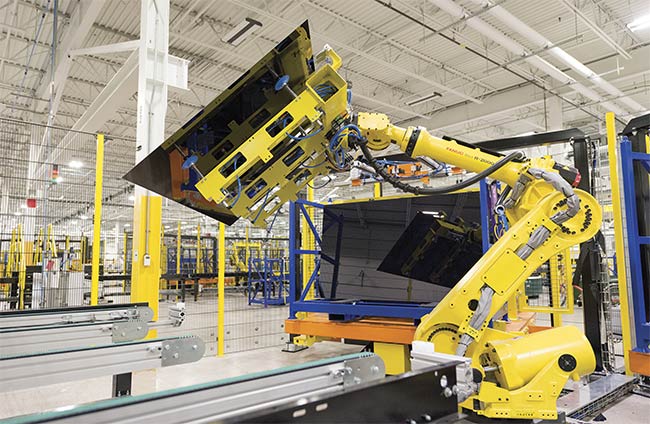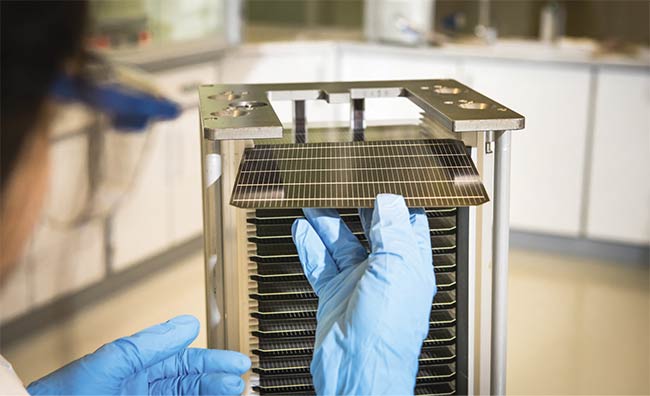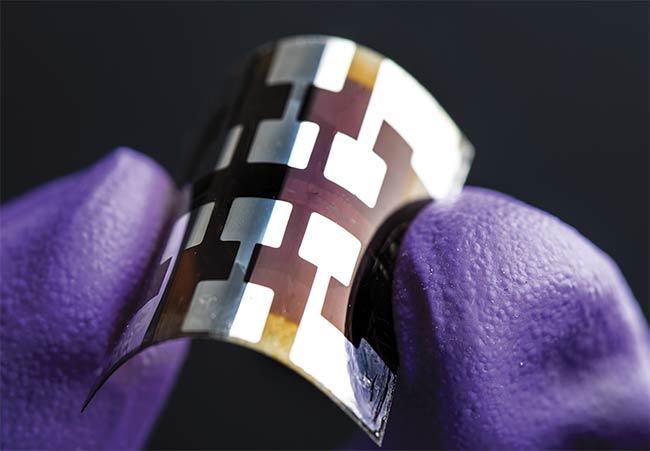With the goal of reducing global CO2 emissions, manufacturers and researchers press forward with photovoltaics, including perovskite and tandem technologies.
HANK HOGAN, CONTRIBUTING EDITOR
It could be a greener world, thanks to photonic technologies. That’s the conclusion of a 2020 study1 forecasting that photonics could eliminate 3 billion tons of CO2 emissions annually by 2030.
Paris-based consultancy Tematys contributed to the study, which showed the extensive impact of photonics. For instance, optical communication reduces the energy needed to move data around and will save an estimated 40 million tons of CO2 emissions yearly, or 1.3% of the
3 billion ton total. Additionally, some data center operators — including Amazon, Facebook, Google, and Microsoft — buy renewable energy among the mix of sources they use. These operators either already have or are moving toward 100% renewable sources. Some of this energy could come from photovoltaics (PVs), which would provide another boost to photonics-driven sustainability.

Tens of gigawatts of photonics-based solar power are now being installed annually. Courtesy of First Solar Inc.
“Photonics brings improvement at many stages of the value chain,” said Benoît d’Humières, a Tematys partner. “Even if one by one they may not appear significant, if you add them all, you realize how much photonics is an enabler for more sustainability-friendly technology.”
By reducing carbon dioxide emissions by 2.1 billion tons a year, photovoltaics will account for over two-thirds of the study’s projected savings. (For a discussion of lighting, the second largest emitter, see sidebar “LEDs Light the Way.”) For PVs, however, sustainability challenges still confront industry and researchers.
Photovoltaics
The dominant photovoltaic technology is crystalline silicon, the same material used to make computer chips. Thanks to material and manufacturing advancements, electricity from PVs is now cost-competitive with that from fossil fuels, according to the International Renewable Energy Agency2. As a result, tens of gigawatts are being added to existing solar generation capacity every year.

Advancements in materials and innovations in the manufacturing of photovoltaic panels, such as increasing automation, have cut the cost of solar power so that it is competitive with other electricity sources. Courtesy of First Solar Inc.
Since nothing lasts forever, the challenge will eventually shift from not just manufacturing but also to recycling all those PV modules. Today, recycling can be difficult, particularly when it comes
to a module’s silicon and glass. Partly
in consideration of this issue, First Solar of Tempe, Ariz., chose a different approach, according to Andreas Wade,
the company’s global sustainability
director.
Reuse, recycle
“From the beginning, from 2005, we also established recycling facilities for our technology at our manufacturing
locations,” Wade said.
The recycling is aided by the company’s use of cadmium telluride (CdTe) instead of crystalline silicon to convert sunlight into electricity. CdTe is a stable compound with an almost ideal absorption band, and it’s relatively easy to deposit a thin layer on glass surfaces, according to Wade. Because the material is such a good absorber, only a few microns of it are needed. In contrast, much more silicon is required to achieve similar conversion efficiency.
First Solar’s latest recycling technology can recover 95% of the CdTe deposited on the glass in a PV module. This recovered cadmium and tellurium can become part of the film put down to make a new PV module, thereby closing the loop, Wade said.
He added that about 97% of the module’s weight is glass, and nine-tenths of it can be recycled. The recovered glass goes into other glass products rather than into new modules.

Tandem structure photovoltaics can be manufactured with perovskite on top of silicon solar cells. The combination of two photoconversion materials boosts the amount of electricity generated from sunlight. Courtesy of Oxford PV.
Another way to handle the looming deluge of retired PV modules is to just make fewer of them and by increasing their solar conversion efficiency, which Wade said exceeds 17% for First Solar’s technology. He said the path to attaining
25% efficiency is fairly clear and, if achieved, would mean one-third fewer modules would be needed to generate an amount of electricity equal to using today’s technology.
Tandem cells
Tandem structures would enable even higher efficiencies. Such constructs have two or more different photoconverting materials layered atop one another. The top material absorbs some of the light and passes it to the next layer, with each layer converting the light it receives into electricity.
“Basically, you’re building a module that goes well beyond the 25% conversion efficiency by harvesting different parts
of the light spectrum with a designed combination of bandgaps,” Wade said.
It’s widely expected that tandem structures will be commercialized within the next decade or so, he noted.
For these constructs, a silicon bottom layer makes increasing economic sense because the cost of silicon photovoltaics continues to fall. The top thin-film layer could be constructed of perovskite, a relatively new PV material that has made significant improvements in conversion efficiency.

Perovskite, a relatively new photovoltaic material, enables high sunlight-to-electricity conversion efficiency and can allow the manufacture of
PV cells on flexible substrates. Courtesy of NREL.
Yarnton, England-based Oxford PV plans to commercialize a silicon-perovskite tandem structure. In its approach, a thin film that contains a perovskite with hybrid organic-inorganic lead as the light-harvesting active layer is deposited on top of a standard crystalline silicon photovoltaic cell.
The perovskite film is less than a half micron thick, according to Chris Case, the company’s chief technology officer. The tandem structure today has a conversion efficiency of 28%, a consequence of the light-capturing characteristics of the perovskite.
“Its absorption is 200 to 400× better than silicon,” Case said.
Oxford PV is running a pilot manufacturing line near Berlin and is building
its first volume production line. The plan is to prove the product in the marketplace by selling higher-performing PV tandem cells as drop-in replacements for existing conventional silicon photovoltaic cells. Oxford PV will then raise money to build a plant capable of producing enough
cells annually to generate gigawatts of electricity.

LED lighting can be up to 80% more energy-efficient than alternatives. Courtesy of Signify.

3D-printed housings can improve the sustainability of lighting by
using less material to create and less fuel to transport. Courtesy of
Signify.
Perovskite PV does have a lot to recommend it, but one potential drawback is the lead used in the thin film, said Tao Xu, a professor of chemistry and biochemistry at Northern Illinois University in DeKalb, Ill. Lead is present in silicon solar cells, and the amount of additional lead found in a perovskite PV is small. However, the perovskite film that contains the lead can be dissolved in water, which means a
broken photovoltaic module could potentially end up putting the metal into the environment. Even low levels of lead
can cause health problems.
The industry and researchers are working on solutions to this issue. Xu and scientists at the National Renewable Energy Laboratory (NREL) in Golden, Colo., recently published a paper3 that details how absorbent layers positioned on the device could trap escaping lead and hold it long enough for a broken module to be removed.
Xu said the absorbent material must be transparent, stable, and highly effective at locking in leached lead. In the paper, the researchers reported that lead leaching out of the perovskite was reduced by more than 96%, but this figure could go up.
“We’re still working on this project to try to minimize the leached lead, hopefully to, let’s say, 99.9%,” Xu said.
Joseph Berry, one of the paper’s co-authors, is a senior scientist and team lead for metal halide perovskite research at NREL. He said perovskite films can have defects but still have high photovoltaic conversion efficiency. Films of different compositions can be layered atop one another. Tuning these layers to capture various parts of the spectrum could push conversion efficiencies above 30%.
Stability, longevity
Before perovskite PV becomes commonplace, though, stability and longevity issues must be solved. As a result of ongoing efforts in this area, Berry said improvement by orders of magnitude has been made in perovskite photovoltaic longevity, but still more is needed. Research that is underway into fundamental chemistry could provide the answers, he said.
As for sustainability, the materials in a perovskite film are all abundant and easily recycled, Berry said. What’s more, the films themselves can be printed, much like ink on a paper — a trait that could make the sustainability impact even greater by altering the economics of perovskite photovoltaics.
“Ultimately our goal is to print them at the same kind of speed that we print newspapers. If you have a highly efficient [photoconversion] material and you can produce them really, really fast, then you can really drive the cost down,” Berry said.
References
1. Messe München et al. (June 2019). Light as the key to global environment sustainability, www.photonics21.org/download/ppp-services/photonics-downloads/Study_GreenPhotonics_2020_final.pdf.
2. International Renewable Energy Agency (May 2019). Renewable power generation costs in 2018, www.irena.org/publications/2019/May/Renewable-power-generation-costs-in-2018.
3. Xun Li et al. (Feb. 19, 2020). On-device lead sequestration for perovskite solar cells. Nature, Vol. 578, pp. 555-558, www.doi.org/10.1038/s41586-020-2001-x.
LEDs Light the Way
While photovoltaics account for the bulk of projected carbon savings by 2030, energy-efficient lighting will contribute another 20% due to the switch to LEDs. This transition is already well underway.
Nicola Kimm is head of sustainability at Signify, an Eindhoven, Netherlands-based company that used to be called Philips Lighting. According to Kimm, in 2012 only 22% of the company’s sales came from LEDs, compared to 78% in 2019. This growth has occurred in part due to falling prices, including the drop in cost of a consumer LED bulb from $25 in 2012 to roughly one-tenth of
that in 2020.
Another reason for the change was the new lighting technology’s other attributes. “LED lighting can be up to 80% more energy-efficient than conventional lighting in some applications,” Kimm said.
Teaming LEDs with photovoltaics can save even more energy. During months when
sunshine is abundant, for example, PVs can convert it to power, which is stored for later use in lighting. In months with less sunshine, the lighting system can use electricity from the grid. Solar harvesting and intelligent
controls are why the global electricity consumption for lighting, which was 13% in 2018, is expected to decline to 8% by 2030, even though the number of light points is projected to grow by 35%, according to Kimm.
As for other sustainability aspects, she said 3D printing of lighting housing cuts the housing’s carbon footprint by 47%. Signify’s 3D-printed products use a polymer that is recyclable, and the housing of 3D-printed parts weighs less than traditional housings, helping to reduce carbon emissions in shipping by a third.